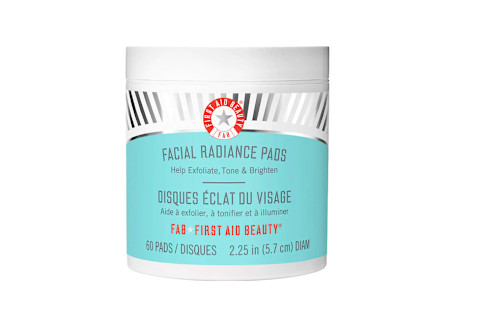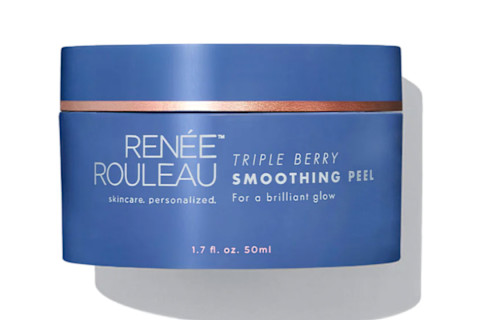Glycolic Acid: Benefits, How To Use It Correctly & Best Products

So you want to exfoliate your skin. Great! But before you go to town with scrubs and peels aplenty, you’ll want to weigh your formula options. Physical or chemical? Cleanser or serum? AHA or BHA?
If you're looking for a radiant, smooth skin texture, allow us to introduce you to glycolic acid—a superstar ingredient for sloughing off dead skin cells with ease. Peruse our full glycolic acid guide below (which includes product recommendations!), and you'll want to add it to your beauty lineup, stat.
What is glycolic acid?
Glycolic acid is an alpha-hydroxy acid (AHA) derived from plants (typically sugar-cane, pineapple, and beets). “Alpha-hydroxy acids are used for chemical exfoliation of the skin,” board-certified dermatologist Hadley King, M.D., reminds us. “They dissolve the bonds that hold dull, dead skin cells on the surface of the skin so the skin will gently shed, revealing smoother, brighter skin underneath.”
It also has the smallest molecular weight of all the AHAs. “This means it can go deep down into your dermis to break up the bonds holding the dead skin cells together,” says board-certified dermatologist Shereene Idriss, M.D., founder of Idriss Dermatology in NYC. It also means glycolic acid does its work rather quickly. That’s why many feel an instant tingling sensation (or irritation, which we’ll get into later).
Benefits for skin
This mighty AHA packs a punch.
Promotes cell turnover
First and foremost: “Its main benefit is exfoliation, which helps skin renewal, reduces the appearance of fine lines, supports texture changes, and helps prevent the clogging of pores,” says board-certified dermatologist Elena Jones, M.D., chief dermatologist of Humanrace.
Hydrates simultaneously
Like other AHAs, glycolic acid unglues dead skin cells from the topmost layer, but it also provides moisturizing qualities as well. “[A] fun fact that’s not so well known is that glycolic acid is also a humectant!” Idriss adds. (Meaning, it attracts water into the skin.) “So while it exfoliates your skin, it also has the ability to retain moisture and will not dry you out in the process.”
Great for acne & acne scars
By sloughing off dead skin cells and preventing clogged pores, glycolic acid can help keep acne at bay.
Plus, a study on glycolic acid's ability to treat acne scars1 showed that the exfoliant is superior in reducing the appearance of those scars; even low-strength daily products were shown to be effective, which is great for those who can't tolerate an intense chemical peel.
Smooths fine lines
Research notes that AHAs (hello, glycolic acid!) can help ease fine lines and wrinkles2.
Fades dark spots
Because it works on the surface (rather than penetrating into the pores; that'll be your BHAs), glycolic acid can slough off pigmented skin and encourage cell turnover.
A systematic review even showed that glycolic acid peels led to significant improvements in pore size, rhytids (meaning wrinkles), and radiance3.
Reduces sun damage
One study found that UVB-burned skin healed sooner4 when treated with glycolic acid for seven days. You definitely don't want to exfoliate fresh burns (ouch), but treating with glycolic acid can help ease that damage after the fact.
Stimulates collagen
“Last, one of the most beneficial qualities: Glycolic acid helps boost collagen production!” Says Idriss. “By promoting collagen synthesis, it can help improve skin elasticity and maintain that bounce in your skin.”
King echoes the statement: “Studies have shown, for example, that six months of topical glycolic acid stimulates a 27% increase in epidermal thickness5,” she notes. That’s why you can find the active in many collagen-restoring routines.
Who should use it?
Short answer? Any skin type can benefit from this AHA, but those with aging skin might find it particularly helpful, thanks to its collagen-stimulating abilities.
Even those with sensitive skin can still take part; although, you’ll want to be more mindful of the concentration. “Sensitive skin types should start with a lower percentage strength and slowly use products with glycolic acid weekly; its frequency of use and its strength can be increased as tolerated,” notes Jones.
Oily skin types, on the other hand, may be able to tolerate a higher strength of the AHA, along with more frequent use. “Dry skin types may tolerate glycolic acid but may need to add additional moisture,” she explains. “It’s important to listen to your skin and adjust as needed.”
How to use it in your routine
You can use glycolic acid in a variety of methods: an active cleanser, a mask, serum, toner, and the list goes on. How you use it will ultimately depend on personal preference. For instance, Jones and Idriss prefer wash-off products (like masks), while King loves a glycolic acid-soaked peel pad. “I think they make it easy to achieve an even application,” she explains.
A wash-off product, however, can allow more sensitive skin types to reap the benefits of this AHA, sans irritation (since you aren’t leaving it on all night long). With a serum or toner, it’s easy for some to over-exfoliate, says Jones. “With a mask, you use it up to three times a week and will not go overboard,” she adds.
No matter which product you choose, make sure to use it at night, since AHAs like glycolic acid can make skin more photosensitive.
It’s crucial that you don’t follow up with any harsh actives in your routine (even retinol), since glycolic acid is pretty strong. Stick to a gentle cleanser (unless that’s your preferred glycolic acid product), nourishing moisturizer, humectant serums, etc.
You’ll also want to start low and slow with the AHA (i.e., a lower concentration one to two nights a week), working your way up to a regular cadence: The average person can handle two to three times a week, but make sure you know when your skin barrier has had enough.
And as always, give yourself a patch test before trying any new product.
Best glycolic acid products
What about chemical peels?
Now, you might have heard whispers about glycolic acid chemical peels, which are one of the most common AHA peels used in dermatologists' offices.
"Chemical peels can address a number of skin concerns. These include acne, uneven skin tone, blemishes, enlarged pores, melasma, dark spots from sun damage, and fine lines," says board-certified dermatologist Brendan Camp, M.D., FAAD, about the treatment.
Because they’re done in a clinical setting, professionals can use much stronger concentrations than an at-home solution. Think 40 to 50% compared to a 10 to 20% skin care formula.
Those with very sensitive skin should opt out of classic chemical peels, as the potent acids can be irritating. The healing process is also quite lengthy and requires a lot of downtime. That being said: Glycolic acid peels are powerful and effective, but you might want to consider gentler, at-home methods before diving right in.
Can you use it with retinol?
“Yes, but I would not recommend using them at the same time in the routine,” says King. Some folks like to alternate exfoliating and retinol nights while introducing some recovery nights (focusing solely on hydration and skin barrier support) in between—this is a concept known as skin cycling.
By exfoliating with glycolic acid first, you dissolve any dead skin cells that could get in the way of your next step; so when you use your retinol the next night, it will penetrate even deeper.
“Now if you are a skin care veteran—meaning, you tolerate retinol well and have been using it for quite a long time—you can get away with using glycolic acid and retinol on the same night,” says Idriss. It’s not something we recommend unless you personally get the green light from a dermatologist, but it is technically possible.
“As always, be sure to follow up with sunscreen the morning after, as your skin will be more sun sensitive,” Idriss adds.
Can you use it with vitamin C?
“Absolutely! Glycolic acid and vitamin c are two essential ingredients needed in a routine to target hyperpigmentation,” says Idriss. You just might want to proceed with caution here, since some forms of vitamin C (namely, ascorbic acid) can be irritating for sensitive skin.
To mitigate any potential risk, you can always just use glycolic acid at night and vitamin C in the morning. The latter can provide an extra layer of sun protection, anyway: "I like my antioxidants in the daytime because there is some evidence to suggest they can work with sunscreen to impart environmental protection6," board-certified dermatologist Elizabeth Tanzi, M.D., previously told mbg.
What are the side effects?
Because glycolic acid has a smaller molecular size and penetrates more easily into the skin, that means it's a little more heavy-duty than some of the other AHAs.
If you find glycolic acid irritating, you might want to opt for an AHA with larger molecules, like lactic acid or mandelic acid. “Or look for gentle formulations of glycolic acid that contain a low percentage combined with ingredients that soothe, hydrate, and support the skin barrier,” notes King.
Even if you can tolerate glycolic acid, it is possible to overdo it: “Dryness, redness, irritation, and flaking can result from over-exfoliation with too much glycolic acid,” says King. Again, find your exfoliating sweet spot and stick to a schedule that works for your skin.
Finally, glycolic acid (and any other AHA) can make your skin more susceptible to sun damage, so always, always pair it with sunscreen.
FAQ
What does glycolic acid do to your skin?
To put it simply: “Its main benefit is exfoliation which helps skin renewal, reduces the appearance of fine lines, supports texture changes, and helps prevent the clogging of pores,” says Jones. “However, it’s also known to stimulate collagen production and bolster the skin’s moisture barrier.”
Is it OK to use glycolic acid every day?
“Hard no! Exfoliation should be reserved for 3 to 4 nights a week max,” says Idriss. “Over-exfoliation leads to a disrupted skin barrier and nobody wants that.” See here to suss out your own exfoliating schedule.
Does glycolic acid remove dark spots?
It sure does! “Glycolic acid helps fade dark spots and hyperpigmentation by promoting the shedding of pigmented skin cells, leading to more even-toned skin,” says Idriss.
It won’t bleach or lighten the skin, but sloughing off dead cells and nudging new ones to the surface will make skin look brighter and more balanced.
Can you use glycolic acid on armpits?
Using glycolic acid on armpits has become a popular natural deodorant technique, as the AHA effectively lowers your skin's pH and makes it too acidic for odor-causing bacteria to thrive. It can also help smooth a bumpy texture and fade discoloration in the area. However, we don’t recommend applying just any glycolic acid toner or serum on your pits. If an acid-based deodorant contains glycolic acid, that’s fine, but proceed with caution—especially if you have sensitive skin.
“You can use glycolic acid under your armpits to help smoothen and brighten your skin. The same rules that apply for your face apply to your armpits,” says Idriss. “However, it’s about damn time to normalize dark underarms, because it is completely normal!”
The takeaway
Looking for a targeted treatment to help fade acne scars, restore collagen, and smooth fine lines?
Glycolic acid is your guy. It's always best to consult your derm before diving right in, but generally speaking, glycolic acid can be a lovely addition to your skin care arsenal. Consider this AHA your newest go-to—or for those searching for something a tad gentler, lactic and mandelic acids work wonders, too.
6 Sources
- https://pubmed.ncbi.nlm.nih.gov/11095203/
- https://www.ncbi.nlm.nih.gov/pmc/articles/PMC3941867/#:~:text=The%20well%2Dknown%20benefits%20of,AHA%20compounds%2C%20extracted%20from%20sugar.
- https://www.ncbi.nlm.nih.gov/pmc/articles/PMC3875240/
- https://pubmed.ncbi.nlm.nih.gov/8634805/
- https://pubmed.ncbi.nlm.nih.gov/12839261/
- https://www.ncbi.nlm.nih.gov/pmc/articles/PMC3673383/








